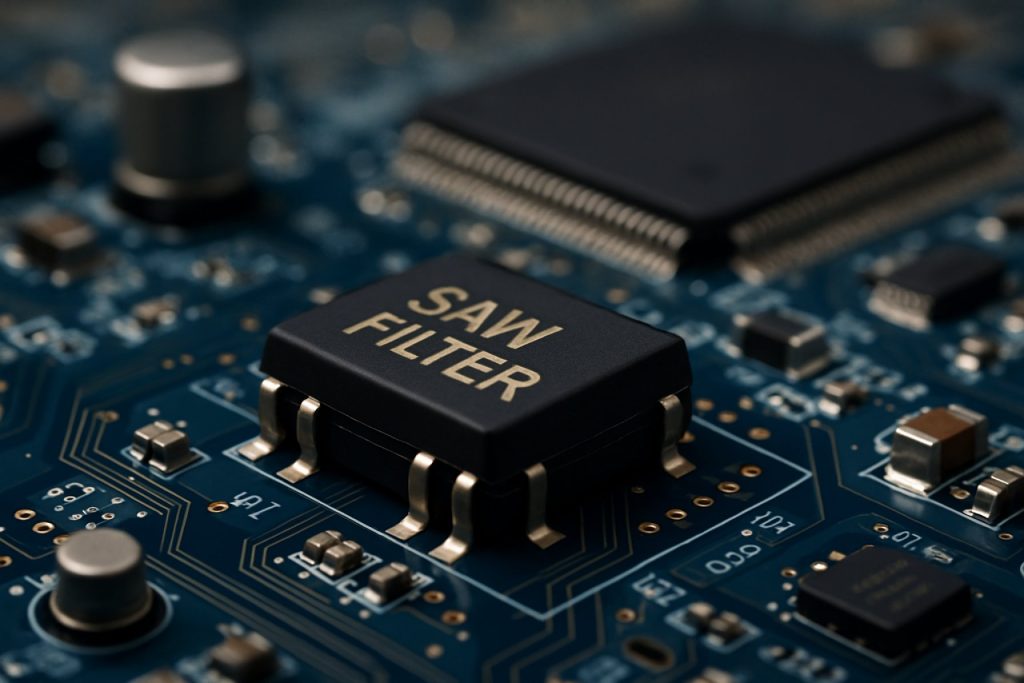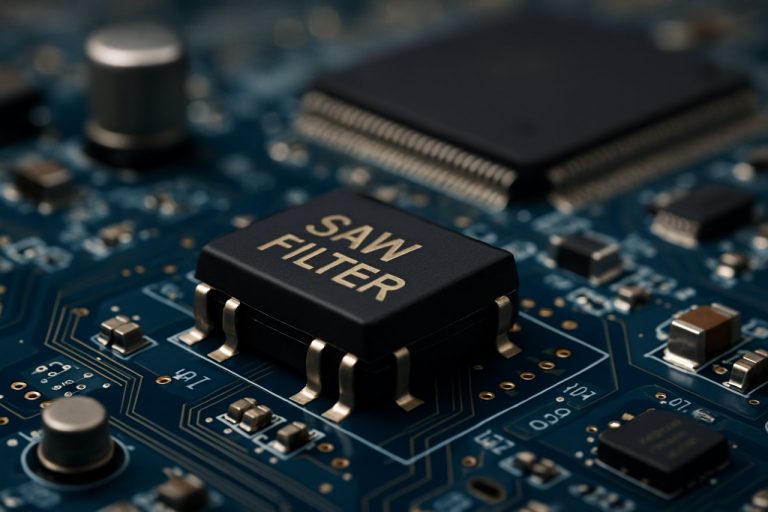
2025 Surface Acoustic Wave Filters for 5G Applications: Market Dynamics, Technology Innovations, and Strategic Insights. Explore Growth Drivers, Regional Trends, and Competitive Analysis for the Next Five Years.
- Executive Summary & Market Overview
- Key Technology Trends in Surface Acoustic Wave Filters for 5G
- Competitive Landscape and Leading Players
- Market Growth Forecasts (2025–2029): CAGR, Revenue, and Volume Analysis
- Regional Market Analysis: North America, Europe, Asia-Pacific & Rest of World
- Future Outlook: Emerging Applications and Investment Opportunities
- Challenges, Risks, and Strategic Opportunities in the 5G SAW Filter Market
- Sources & References
Executive Summary & Market Overview
Surface Acoustic Wave (SAW) filters are critical components in radio frequency (RF) front-end modules, enabling the selection and management of specific frequency bands in wireless communication systems. With the global rollout of 5G networks accelerating, the demand for high-performance, cost-effective filtering solutions has surged. SAW filters, known for their compact size, low insertion loss, and high selectivity, are increasingly favored in 5G applications, particularly for sub-6 GHz frequency bands.
In 2025, the global market for SAW filters tailored to 5G applications is projected to experience robust growth. This expansion is driven by the proliferation of 5G-enabled devices, the densification of small cell infrastructure, and the ongoing evolution of the Internet of Things (IoT). According to Gartner, the number of 5G connections worldwide is expected to surpass 2 billion by 2025, significantly boosting the demand for advanced RF components such as SAW filters.
Market leaders including Murata Manufacturing Co., Ltd., TDK Corporation, and Skyworks Solutions, Inc. are investing heavily in R&D to enhance the performance and miniaturization of SAW filters. These efforts are aimed at meeting the stringent requirements of 5G networks, such as higher data rates, lower latency, and improved spectral efficiency. Notably, SAW filters are particularly well-suited for the sub-3 GHz spectrum, which remains a primary focus for initial 5G deployments due to its favorable propagation characteristics and existing infrastructure compatibility.
- Key Market Drivers: The rapid adoption of 5G smartphones, expansion of wireless infrastructure, and increasing integration of RF front-end modules in consumer electronics.
- Challenges: The emergence of Bulk Acoustic Wave (BAW) filters for higher frequency bands (above 3 GHz) and the need for continuous innovation to address performance limitations in high-frequency 5G applications.
- Regional Insights: Asia-Pacific leads the market, driven by aggressive 5G rollouts in China, South Korea, and Japan, while North America and Europe are witnessing steady growth due to ongoing network upgrades and device launches.
Overall, the SAW filter market for 5G applications in 2025 is characterized by intense competition, rapid technological advancements, and a strong alignment with the evolving needs of next-generation wireless communication systems. Strategic partnerships and investments in advanced manufacturing processes are expected to further shape the competitive landscape in the coming years (MarketsandMarkets).
Key Technology Trends in Surface Acoustic Wave Filters for 5G
Surface Acoustic Wave (SAW) filters are pivotal components in the radio frequency (RF) front-end modules of 5G devices, enabling efficient signal selection and interference mitigation. As 5G networks expand globally in 2025, several key technology trends are shaping the evolution and adoption of SAW filters for these advanced applications.
- Miniaturization and Integration: The demand for compact, multi-band 5G smartphones and IoT devices is driving the miniaturization of SAW filters. Manufacturers are increasingly integrating SAW filters with other RF components, such as duplexers and multiplexers, into single modules. This trend is exemplified by the development of highly integrated RF front-end solutions by companies like Qorvo and Skyworks Solutions, Inc., which enable device makers to save board space and reduce power consumption.
- Enhanced Frequency Selectivity: 5G networks operate across a broader and more fragmented spectrum, including sub-6 GHz and, to a lesser extent, mmWave bands. SAW filter technology is advancing to provide sharper frequency selectivity and higher out-of-band rejection, crucial for mitigating interference in dense 5G environments. Innovations in electrode design and advanced piezoelectric materials are central to these improvements, as highlighted in recent research from Murata Manufacturing Co., Ltd..
- Thermal Stability and Power Handling: The proliferation of carrier aggregation and higher transmit power in 5G devices necessitates SAW filters with improved thermal stability and power handling. New material systems, such as lithium tantalate (LiTaO3) and lithium niobate (LiNbO3), are being adopted to enhance filter performance under demanding conditions, as reported by TDK Corporation.
- Cost-Effective Mass Production: As 5G device volumes surge, cost-effective manufacturing of SAW filters becomes increasingly important. Advances in wafer-level packaging and automated production lines are enabling high-volume, low-cost output without compromising performance, a trend underscored by Yole Group’s market analysis.
- Emergence of Hybrid Solutions: To address the limitations of SAW filters at higher frequencies, hybrid solutions combining SAW and Bulk Acoustic Wave (BAW) technologies are gaining traction. These hybrid modules optimize performance across the full 5G spectrum, as seen in product portfolios from Broadcom Inc..
Collectively, these technology trends are enabling SAW filters to meet the stringent requirements of 5G applications in 2025, supporting higher data rates, lower latency, and greater device integration.
Competitive Landscape and Leading Players
The competitive landscape for surface acoustic wave (SAW) filters in 5G applications is characterized by intense rivalry among established component manufacturers and a growing influx of new entrants, driven by the rapid global rollout of 5G networks. The market is dominated by a handful of key players with strong technological capabilities, extensive patent portfolios, and robust supply chain integration. These companies are leveraging their expertise in radio frequency (RF) front-end modules to address the stringent performance requirements of 5G, such as higher frequency operation, miniaturization, and improved power efficiency.
Murata Manufacturing Co., Ltd. remains a global leader in SAW filter technology, consistently investing in R&D to enhance filter performance for sub-6 GHz 5G bands. The company’s proprietary design and manufacturing processes enable high-volume production of compact, high-performance SAW filters, which are widely adopted in smartphones and IoT devices.
TDK Corporation is another major player, offering a comprehensive portfolio of SAW and bulk acoustic wave (BAW) filters. TDK’s focus on advanced materials and miniaturization has positioned it as a preferred supplier for leading handset manufacturers and network equipment vendors.
Skyworks Solutions, Inc. and Qorvo, Inc. are prominent U.S.-based competitors, both of which have made significant strides in integrating SAW filters into complex RF front-end modules tailored for 5G smartphones and infrastructure. Their ability to deliver highly integrated solutions with low insertion loss and high selectivity is a key differentiator in the market.
Other notable participants include KYOCERA AVX Components Corporation and TAIYO YUDEN CO., LTD., both of which are expanding their SAW filter offerings to address emerging 5G use cases, such as automotive connectivity and industrial IoT.
Strategic partnerships, mergers, and acquisitions are common as companies seek to expand their technological capabilities and global reach. For example, the collaboration between Murata and TAIYO YUDEN on advanced filter technologies exemplifies the industry’s focus on innovation and supply chain resilience. As 5G adoption accelerates into 2025, competition is expected to intensify, with leading players investing heavily in R&D to address the evolving demands of next-generation wireless communication.
Market Growth Forecasts (2025–2029): CAGR, Revenue, and Volume Analysis
The market for Surface Acoustic Wave (SAW) filters in 5G applications is poised for robust growth between 2025 and 2029, driven by the rapid global rollout of 5G networks and the escalating demand for high-frequency, low-loss filtering solutions in mobile devices and infrastructure. According to projections by MarketsandMarkets, the global SAW filter market is expected to achieve a compound annual growth rate (CAGR) of approximately 8.5% during this period, with 5G applications representing the fastest-growing segment.
Revenue from SAW filters dedicated to 5G is forecasted to reach $2.1 billion by 2029, up from an estimated $1.3 billion in 2025. This surge is attributed to the proliferation of 5G-enabled smartphones, IoT devices, and small cell base stations, all of which require advanced RF filtering to manage increased signal complexity and mitigate interference. Gartner highlights that the ongoing expansion of 5G infrastructure, particularly in Asia-Pacific and North America, will be a key revenue driver for SAW filter manufacturers.
In terms of volume, the shipment of SAW filters for 5G is projected to exceed 7.5 billion units by 2029, reflecting a CAGR of 9.2% from 2025. This volume growth is underpinned by the increasing integration of SAW filters in consumer electronics, automotive telematics, and industrial IoT modules. Statista reports that 5G smartphone shipments alone are expected to surpass 1.5 billion units annually by 2029, further fueling demand for high-performance SAW filters.
- CAGR (2025–2029): 8.5% (revenue), 9.2% (volume)
- Revenue (2025): $1.3 billion
- Revenue (2029): $2.1 billion
- Volume (2029): 7.5 billion units
Key market players such as Murata Manufacturing Co., Ltd., Skyworks Solutions, Inc., and Qorvo, Inc. are expected to benefit significantly from these trends, investing in R&D to enhance filter performance for sub-6 GHz and mmWave 5G bands. The competitive landscape will likely intensify as new entrants and established firms vie for market share in this high-growth segment.
Regional Market Analysis: North America, Europe, Asia-Pacific & Rest of World
The global market for Surface Acoustic Wave (SAW) filters in 5G applications is experiencing dynamic regional shifts, with North America, Europe, Asia-Pacific, and the Rest of the World (RoW) each exhibiting distinct growth patterns and drivers as of 2025.
North America remains a pivotal market, propelled by aggressive 5G rollouts and the presence of leading telecom operators and device manufacturers. The United States, in particular, is witnessing robust demand for SAW filters due to the rapid expansion of 5G infrastructure and the proliferation of connected devices. Key players such as Skyworks Solutions and Qorvo are investing in advanced SAW filter technologies to address the region’s stringent performance and miniaturization requirements. The North American market is further buoyed by government initiatives supporting 5G spectrum allocation and network densification.
Europe is characterized by a steady adoption curve, with countries like Germany, the UK, and France leading 5G deployments. The region’s focus on industrial IoT, automotive connectivity, and smart city projects is driving the integration of SAW filters in a variety of 5G-enabled devices. European manufacturers, including Murata Manufacturing (with significant operations in the region), are collaborating with telecom operators to develop customized SAW solutions for sub-6 GHz frequency bands, which are prevalent in European 5G networks.
Asia-Pacific dominates the global SAW filter market for 5G, both in terms of production and consumption. China, South Korea, and Japan are at the forefront, with aggressive 5G infrastructure investments and a high concentration of smartphone and network equipment manufacturers. Companies such as TDK Corporation and Taiyo Yuden are scaling up production capacities to meet surging demand. The region’s leadership is further reinforced by government-backed 5G initiatives and the rapid adoption of 5G-enabled consumer electronics.
Rest of the World (RoW) is gradually emerging, with countries in the Middle East and Latin America initiating 5G trials and early deployments. While the market size remains modest compared to other regions, increasing investments in telecom infrastructure and the entry of global OEMs are expected to drive future demand for SAW filters in these markets.
Overall, regional dynamics in 2025 reflect a strong correlation between 5G rollout maturity, local manufacturing capabilities, and the adoption of advanced SAW filter technologies, with Asia-Pacific leading, followed by North America and Europe, and RoW showing promising potential for long-term growth.
Future Outlook: Emerging Applications and Investment Opportunities
The future outlook for surface acoustic wave (SAW) filters in 5G applications is marked by robust growth prospects, driven by the accelerating global rollout of 5G networks and the increasing complexity of radio frequency (RF) front-end modules. As 5G technology demands higher frequencies, wider bandwidths, and greater device integration, SAW filters are evolving to meet these requirements, particularly in sub-6 GHz bands where they offer cost-effective and high-performance solutions.
Emerging applications for SAW filters in 2025 are expected to extend beyond traditional smartphones and tablets. The proliferation of 5G-enabled Internet of Things (IoT) devices, automotive connectivity (V2X), and industrial automation is creating new demand for compact, energy-efficient, and reliable RF filtering solutions. SAW filters are well-positioned to address these needs due to their small form factor, low insertion loss, and scalability for mass production. Notably, the automotive sector is anticipated to be a significant growth area, as connected vehicles require robust RF filtering for advanced driver-assistance systems (ADAS) and infotainment platforms Qualcomm.
From an investment perspective, the SAW filter market is attracting attention from both established players and new entrants. Leading manufacturers are ramping up R&D to develop advanced SAW filter technologies capable of handling higher frequencies and mitigating interference in dense 5G environments. Strategic partnerships, mergers, and acquisitions are also on the rise, as companies seek to expand their intellectual property portfolios and manufacturing capabilities Murata Manufacturing Co., Ltd.. Venture capital interest is growing, particularly in startups focused on innovative materials and design architectures that promise enhanced performance and lower costs.
- Integration with multi-mode, multi-band RF modules is a key trend, enabling device manufacturers to streamline designs and reduce bill of materials.
- Emerging markets in Asia-Pacific, especially China and India, are expected to drive significant demand as 5G infrastructure deployment accelerates Global mobile Suppliers Association (GSA).
- Environmental and supply chain considerations are prompting investments in sustainable manufacturing and alternative raw materials.
In summary, the outlook for SAW filters in 5G applications through 2025 is highly positive, with expanding use cases and strong investment activity underpinning continued innovation and market expansion.
Challenges, Risks, and Strategic Opportunities in the 5G SAW Filter Market
The rapid deployment of 5G networks has intensified demand for high-performance Surface Acoustic Wave (SAW) filters, which are critical for enabling efficient signal processing in mobile devices and infrastructure. However, the 5G SAW filter market faces a complex landscape of challenges, risks, and strategic opportunities as it moves into 2025.
Challenges and Risks
- Technical Limitations: SAW filters, while cost-effective and suitable for frequencies up to 2.7 GHz, face performance constraints at higher frequencies required by advanced 5G bands (e.g., n77, n78, n79). This limits their applicability compared to Bulk Acoustic Wave (BAW) filters, which are better suited for sub-6 GHz and mmWave applications Murata Manufacturing Co., Ltd..
- Intense Competition: The market is highly competitive, with established players such as Skyworks Solutions, Inc., Qorvo, Inc., and TDK Corporation investing heavily in R&D to enhance filter performance and miniaturization. This puts pressure on margins and accelerates product cycles.
- Supply Chain Vulnerabilities: The global semiconductor supply chain remains susceptible to disruptions, as seen during the COVID-19 pandemic and ongoing geopolitical tensions. These disruptions can delay production and increase costs for SAW filter manufacturers Gartner.
- Intellectual Property Risks: The proliferation of patents and proprietary technologies in the SAW filter space increases the risk of litigation and licensing disputes, potentially hindering innovation and market entry for new players.
Strategic Opportunities
- Mid-Band 5G Expansion: The global rollout of mid-band 5G (3.3–4.2 GHz) presents a significant opportunity for SAW filters, especially in markets prioritizing cost-effective solutions for mass-market devices Ericsson.
- Integration and Miniaturization: Demand for smaller, more integrated RF front-end modules in smartphones and IoT devices is driving innovation in SAW filter design, including the development of multi-band and tunable solutions Qualcomm.
- Emerging Markets: Rapid 5G adoption in Asia-Pacific and emerging economies offers growth potential, as these regions seek affordable, scalable filter solutions for expanding network coverage GSMA.
In summary, while the 5G SAW filter market in 2025 is challenged by technical, competitive, and supply chain risks, it is also positioned to capitalize on mid-band 5G expansion, integration trends, and emerging market demand.
Sources & References
- Murata Manufacturing Co., Ltd.
- Skyworks Solutions, Inc.
- MarketsandMarkets
- Broadcom Inc.
- KYOCERA AVX Components Corporation
- Statista
- Qualcomm



